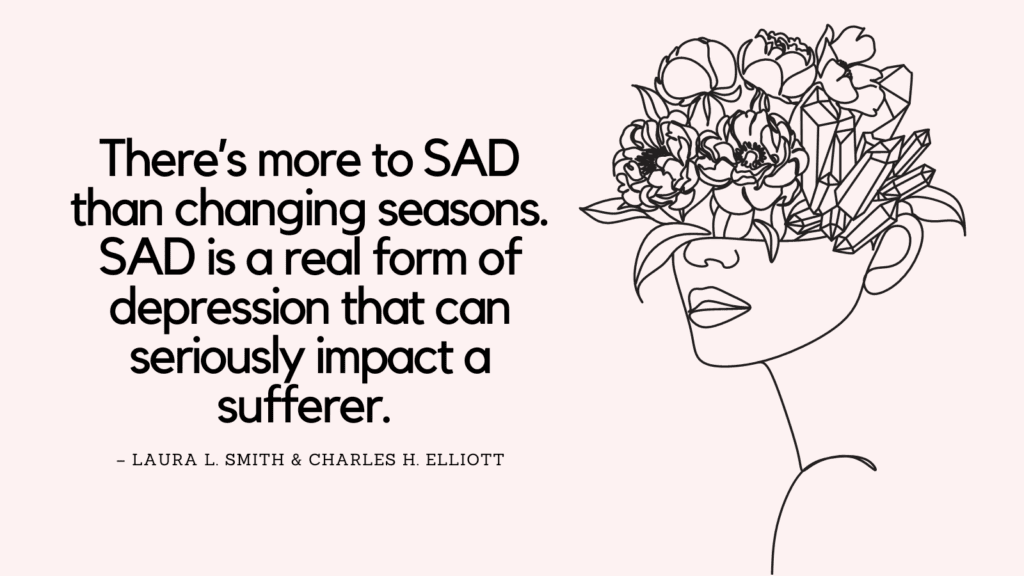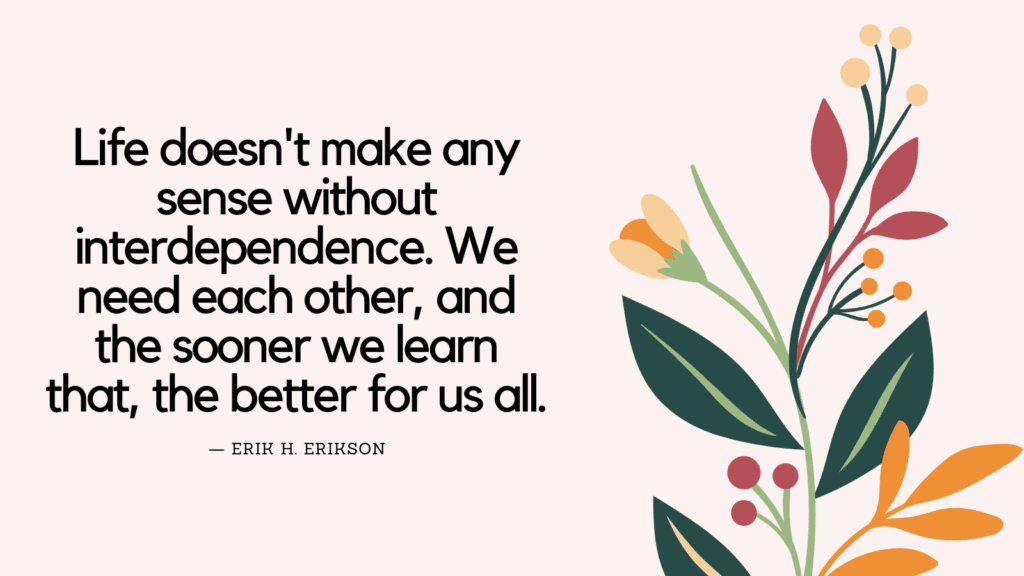This post contains some of the best seasonal affective disorder quotes.
Disclosure: Some of the links below are affiliate links. This means that, at zero cost to you, I will earn an affiliate commission if you click through the link and finalize a purchase.
Seasonal Depression (Seasonal Affective Disorder (SAD))
Seasonal depression, also called seasonal affective disorder (SAD), is a type of depression that’s related to changes in seasons. (*) (*) (*)
SAD begins and ends at about the same times every year and most commonly begins in late fall and continues into the winter months.
Related: Do I Have Seasonal Depression Quiz (+Top 12 Natural Ways To Boost Your Mood)
Seasonal Affective Disorder Quotes
1. “SAD is a type of depression related to the winter season and is common, affecting 1–9% of the U.S. population, depending on latitude.”— Kelly J. Rohan
2. “If you have SAD, sleep probably comes easily, too often, and lasts too long. Getting up is hard to do. Everyone has difficulty getting out of bed from time to time. We both like to hit the snooze button on winter mornings when it’s dark and cold and squeeze in just a few more minutes of sweet sleep. Doing this means that we have to speed up our morning routine, or write one less page in our book that day. These aren’t huge consequences.” – Laura L. Smith & Charles H. Elliott
3. “The way you experience SAD is unique to you. You may feel tired, depressed, or irritable. You may experience changes in appetite or aches and pains. You may have difficulty concentrating or trouble sleeping. Whatever your symptoms, SAD can greatly affect your quality of life, making it difficult to enjoy things the way you used to.”— Kelly J. Rohan
Related: What is Concealed Depression? (Effective 3-Step Guide To Overcome High Functioning Depression)
4. “SAD is a form of clinical depression. SAD is different from nonseasonal depression in that it tends to recur every year and follows a seasonal pattern of onset in the fall or winter and remission in the spring or summer—Kelly J. Rohan
5. “Most people with SAD attribute their misery to the change in seasons. For many, depression arrives in the fall, settles in through the winter, packs up in spring, and leaves in the summer. For them, seasonal shifts appear to cause and cure their depressive symptoms.” – Laura L. Smith & Charles H. Elliott
6. “Most scientists believe that the primary cause of SAD is diminished sunlight that accompanies the shorter days in the winter. For many people, reduced light triggers changes that reverberate throughout their bodies and minds, causing their moods to darken.” – Laura L. Smith & Charles H. Elliott
7. “People who experience moderate changes with the seasons are said to have subsyndromal SAD (S-SAD). The bottom line is that SAD symptoms are very common and get more common as distance from the equator increases.”—Kelly J. Rohan
8. “People suffering from seasonal affective disorder (SAD) typically internalize negative and pessimistic beliefs and feel unable to deal with everyday problems. Fortunately, helping folks change the way they think helps them feel better and live their lives more fully. Literally hundreds of studies support the value of thought therapy for the treatment of depression.” – Laura L. Smith & Charles H. Elliott
9. “People with depression or seasonal affective disorder (SAD) often complain about problems with sleep. Folks with nonseasonally related depression often report not sleeping enough, but SAD sufferers typically say the opposite — that they sleep too much. Neither type of problem is much fun.” – Laura L. Smith & Charles H. Elliott
Related: Journal Prompts For Depression (+FREE Depression Worksheets PDF)
10. “During winter, people with SAD commonly do not engage in many pleasant activities. People with SAD typically have little energy, and their bodies seem to be telling them to sleep, sleep, sleep. You may find that in winter you do a lot of sleeping and sitting around instead of doing things you enjoy. As spring arrives, you begin to be more active.”—Kelly J. Rohan
11. “People with seasonal affective disorder (SAD) dread the turn from fall to winter. Darkness on the outside brings depression on the inside. People with SAD don’t look forward to cozy nights in front of a roaring fire, skiing, making snowmen, or celebrating holidays. Instead, they simply hope and pray that they can muddle through until spring.” – Laura L. Smith & Charles H. Elliott
12. “SAD is more serious than bad moods related to cold weather or cloudy days. People with SAD usually report overwhelming feelings of fatigue, seriously depressed moods, cravings for carbohydrates, and disturbed sleep. These symptoms tend to endure through the winter months and improve in the spring.” – Laura L. Smith & Charles H. Elliott
13. “SAD or any type of depression can be tricky to diagnose because symptoms vary widely from person to person. Some people experience overwhelming fatigue; others feel out of sorts. Many individuals are keenly aware of their hopeless moods while others complain more about vague symptoms, such as feeling run-down or a lack of enthusiasm. The folks in the latter group commonly deny feeling depressed when asked. And sometimes a bad or sad mood is just a bad or sad mood.” – Laura L. Smith & Charles H. Elliott
14. “Decreased activity may come before or after depressed mood. When you are experiencing depressed mood with a SAD episode, you are less motivated to do things. You begin to be less active because you are feeling depressed.”—Kelly J. Rohan
15. “When you are suffering from your SAD symptoms, you may end sitting around thinking about how bad and tired you feel instead of doing a pleasant activity. At these times you may feel worthless, pessimistic about your life, and blame yourself for your own inactivity and fatigue. You may say to yourself something like “I’m so useless I can’t even get off the couch and do something.” These types of thoughts are common among people with SAD. They tend to make people feel even worse and even less likely to do pleasant activities.”—Kelly J. Rohan
16. “People with SAD often have negative thoughts that make them feel worse. These types of thoughts may also keep them from trying the activities that just might make them feel better. Think about the kinds of thoughts that you have when you are considering whether or not to do an activity. If you have negative thoughts such as, “I’m so tired” or, “I won’t enjoy it anyway,” you are less likely to engage in the activity.”—Kelly J. Rohan
16. “Seasonal depression hits for me, like clockwork, the day after Halloween… Thanksgiving is my first warning; Christmas is my second; and New Year’s Eve is not a beginning but an end.” — Dayna Evans
17. “The relationship between SAD and negative thinking is actually a two-way street. Yes, the more depressed you are, the more your thinking turns negative. And as your thinking becomes more negative, your depression deepens. However, there is good news here. Whichever way the cycle starts, you can improve your moods by changing the way you think.” – Laura L. Smith & Charles H. Elliott
18. “The winter blues is similar to, but not as severe as, SAD. You may feel a little down for several days when it’s overcast and cold outside, and that’s not unusual. You’re sludging through mushy snow and getting wet and cold and downright dirty at times (don’t you just hate that sandy salt thrown all over the street and sidewalk?). But for most people, a nice cup of hot chocolate or a cheery fire is enough to perk up their moods until the sun comes out again. Symptoms that are pretty much the same as SAD, just less oppressive and usually fewer in number, persist throughout the winter season.” – Laura L. Smith & Charles H. Elliott
19. “There’s more to SAD than changing seasons. SAD is a real form of depression that can seriously impact a sufferer. Moods associated with SAD can be so dark that the person starts missing work, withdraws from people, and in rare cases, contemplates suicide.” – Laura L. Smith & Charles H. Elliott
Related: Journal Prompts For Depression (+FREE Depression Worksheets PDF)
20. “These estimated fourteen million Americans are said to be suffering from seasonal affective disorder, or SAD, a condition now generally accepted by the medical community and the public at large. Another fourteen percent of the adult U.S. population is estimated to suffer from a lesser form of SAD, known as the winter blues.” – Norman E. Rosenthal
21. “This condition, also known as seasonal affective disorder (SAD), has been shown in many studies in the United States and elsewhere in the world to respond to treatment with bright environmental light (light therapy). Light therapy is no longer considered experimental but is a mainstream type of psychiatric treatment.” – Norman E. Rosenthal
22. “Unlike people with full-blown SAD, some sufferers with the winter blues generally manage their lives okay during the winter. They go to work, attend school, and participate in activities, but they don’t spring into these activities with much enthusiasm or interest (at least not as much as they do in the summer or spring).” – Laura L. Smith & Charles H. Elliott
23. “A highly effective way of alleviating SAD involves using the mind to re-establish good moods, increase energy, and instill hope. Again, the mind, body, and environment interact. When depressed people figure out how to think in nondepressed ways, their brains show improvements in functioning.” – Laura L. Smith & Charles H. Elliott
24. “If you get past your SAD, that’s wonderful. Some people recover from SAD or other types of depression and feel great. But others are left feeling a little flat — not bad, not sad, but a little empty. It’s like SAD consumed their spirit and energy. Winning the battle of SAD leaves them feeling a lack of purpose and meaning.” – Laura L. Smith & Charles H. Elliott
25. “You cannot change the fact that winter will arrive every year, but you can work to change the way you cope with it.”—Kelly J. Rohan
Related: Am I Lonely Quiz (+ Top 5 Tips To Overcome Loneliness)

Best Light Therapy Lamps
References
- Portions of this article were adapted from the book Seasonal Affective Disorder For Dummies, © 2007 by Laura L. Smith & Charles H. Elliott. All rights reserved.







